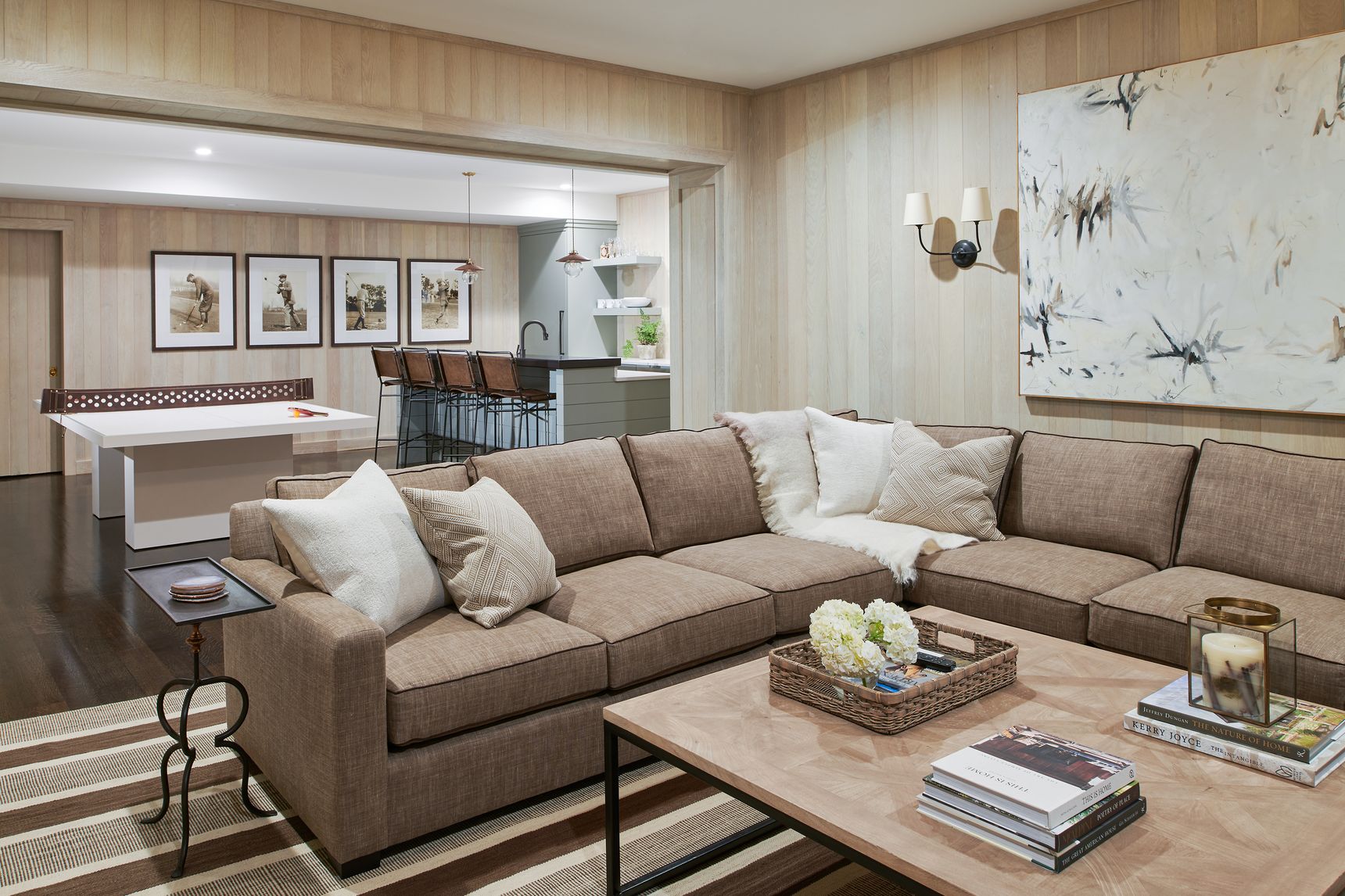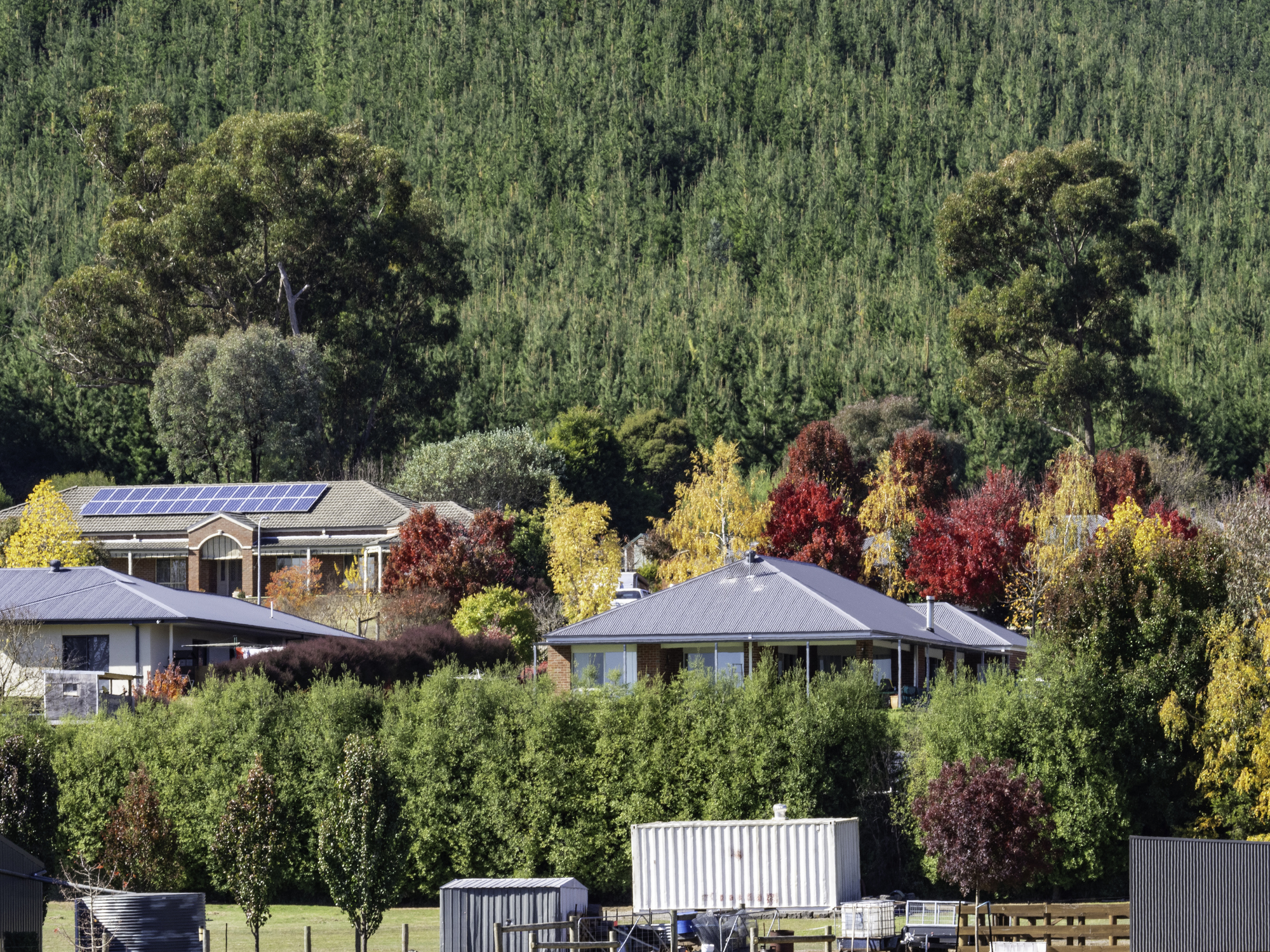5 Interior Design Ideas to Max Out Your Basement Space
Here are the five errors they encounter over and over — and how to avoid them.
EVEN THE MOST casual horror-movie viewers know that basements are where protagonists go to, as TikTok teens would say, “get unalived.” For interior designers, however, the most unnerving part of these spaces isn’t who (or what) might be hiding in wait, it’s often what’s lying in plain sight: their décor.
Too many homeowners treat basements “as a second-class space where old furniture and random junk goes to die,” complained Anelle Gandelman, founder of New York’s A-List Interiors. “A basement is not the place for appeasing your husband with his ugly leather recliner,” echoed West Palm Beach, Fla., designer McCall Dulkys.
Here, architects and designers share five other frequently encountered below-ground blunders and suggest less-frightful alternatives.
1. The ‘All Things’ Space
New York designer Elizabeth Gill lives in fear of families who ask her to turn their cellars into an all-in-one combination gym, playroom, family room, man cave and mother-in-law suite. “Then, I get the stare and a ‘Can you make all that work?’” she said.
Instead: Prioritize. “Determine the most important use of the space and make that the focus,” said Ms. Gill. Any extra living area can be a bonus in a crowded home, she said, “but you ultimately will end up using a space that is functional and complete—not one cluttered with lots of things that detract from the original design.”
2. Fateful Ceiling
A common feature in basements, dropped ceilings suspend large tiles in a metal grid, thereby leaving room to conceal inset lighting, ducts and other mechanicals. But they shave height off a room, contributing to the dreaded cavelike feeling and threatening to behead your taller friends. Other misguided attempts to hide ductwork also bug design pros. Washington, D.C., designer Melissa Sanabria’s peeve is soffits whose bottoms have been painted to match the ceilings and sides to match the walls, creating a two-toned effect.
Instead: According to New York designer Robin Wilson, 8-inch-deep high-hat lights, which need dropped ceilings, are a fixture of the past. Use new, shallow-profile overhead LED lights. Conceal ductwork and pipes in a dropped bulkhead that appears designed and purposeful around the perimeter of a ceiling, advised Bethesda, Md., designer Tamara Gorodetzky. Where a soffit is unavoidable, “paint walls, ceiling and every side of the soffit the same colour so everything disappears,” Ms. Sanabria said.
3. Pall-Casting
Leave the flickering fluorescents to “The Exorcist.” Basements are dark spaces, “and improper lighting creates uneven, shadowy areas,” said New York designer Rozit Arditi.
Instead: Even if you’re going for a moody man cave, “you need good lighting that can be fully illuminated and also dimmed for cozy ambience,” said Charlotte, N.C., designer Layton Campbell. Incorporate a mix of light sources such as floor lamps, table lamps and sconces so you needn’t depend on one overhead fixture, advised Ms. Arditi. Linear, ceiling-tracked LED lights can help lead the way from one space into the next, said Mary Maydan, an architect in Palo Alto, Calif., who installs them with a 90-degree bend as they flow from a hallway into an adjacent family room. “This creates continuity and makes the corridor act as an invitation into the next space.”
4. Neglected Nooks
Irregular areas of foundations are often covered over or turned into closets. “But especially in basements that are largely open, these odd and unusual shapes offer special moments for decoration,” said William Cullum, senior designer at Jayne Design Studio, in New York City.
Instead: Knocking down walls and rejiggering spaces is expensive, so get creative with what you have and use it as an opportunity to try something you’d never risk on the first floor, Mr. Cullum said. For one Oyster Bay, N.Y., basement (shown above), Mr. Cullum made a banquette that conforms to a polygonal footprint, established by the breakfast room above, and installed curtains on an existing steel beam, creating a special reading nook with a cozy, tented feel. “It’s a small retreat within an expansive space,” he said.
5. Wannabe Wood
Dark, dank 1970s-style panelling comes across as hopelessly dated and usually represents a “total departure from the rest of the house” said architect Margie Lavender, principal at New York City’s Ike Kligerman Barkley. Old-fashioned panelling is not moisture-resistant and can be a place where mould grows, added Ms. Wilson.
Instead: Ms. Wilson uses thin brick cladding or dry wall back with cement instead of paper—typically used in bathroom renovations—to prevent mould growth. Stick with light colours to maximize limited light, advised Ms. Lavender, and consider an accent wall of high-gloss tile, in cream or robin’s egg blue, to add texture and reflect light.
Notes From Underground
Strange basement décor
“I got totally freaked out when I walked into a basement that housed an antique doll collection. Cue the scary horror music.” —Layton Campbell, designer, Charlotte, N.C.
“A full barbecue grill with a chimney at one end and a wood-burning fireplace on the opposite side. I can understand a man cave, but to have two fire-generating things in a basement could mean that your house burns down.” —Robin Wilson, designer, New York
“I was asked to help a client display his collection of medieval torture tools.” —Tracy Morris, designer, McLean, Va.
“Every wall was covered with PEZ candy dispensers. It was quite the collection.” —Sterling McDavid, designer, New York, N.Y.
“A toilet in the basement without any sort of enclosure.” —Luke Olson, senior associate, GTM Architects, Bethesda, Md.
“A potential client had a hot tub in the basement. It was odd and immediately felt like some weird castle dungeon with the smell of chlorine and mould.” —Miriam Verga, designer, Mimi & Hill Interiors, Westfield, N.J.
Reprinted by permission of The Wall Street Journal, Copyright 2021 Dow Jones & Company. Inc. All Rights Reserved Worldwide. Original date of publication: October 5
 Copyright 2020, Dow Jones & Company, Inc. All Rights Reserved Worldwide. LEARN MORE
Copyright 2020, Dow Jones & Company, Inc. All Rights Reserved Worldwide. LEARN MORE
This stylish family home combines a classic palette and finishes with a flexible floorplan
Just 55 minutes from Sydney, make this your creative getaway located in the majestic Hawkesbury region.
As Paris makes its final preparations for the Olympic games, its residents are busy with their own—packing their suitcases, confirming their reservations, and getting out of town.
Worried about the hordes of crowds and overall chaos the Olympics could bring, Parisians are fleeing the city in droves and inundating resort cities around the country. Hotels and holiday rentals in some of France’s most popular vacation destinations—from the French Riviera in the south to the beaches of Normandy in the north—say they are expecting massive crowds this year in advance of the Olympics. The games will run from July 26-Aug. 1.
“It’s already a major holiday season for us, and beyond that, we have the Olympics,” says Stéphane Personeni, general manager of the Lily of the Valley hotel in Saint Tropez. “People began booking early this year.”
Personeni’s hotel typically has no issues filling its rooms each summer—by May of each year, the luxury hotel typically finds itself completely booked out for the months of July and August. But this year, the 53-room hotel began filling up for summer reservations in February.
“We told our regular guests that everything—hotels, apartments, villas—are going to be hard to find this summer,” Personeni says. His neighbours around Saint Tropez say they’re similarly booked up.
As of March, the online marketplace Gens de Confiance (“Trusted People”), saw a 50% increase in reservations from Parisians seeking vacation rentals outside the capital during the Olympics.
Already, August is a popular vacation time for the French. With a minimum of five weeks of vacation mandated by law, many decide to take the entire month off, renting out villas in beachside destinations for longer periods.
But beyond the typical August travel, the Olympics are having a real impact, says Bertille Marchal, a spokesperson for Gens de Confiance.
“We’ve seen nearly three times more reservations for the dates of the Olympics than the following two weeks,” Marchal says. “The increase is definitely linked to the Olympic Games.”

Getty Images
According to the site, the most sought-out vacation destinations are Morbihan and Loire-Atlantique, a seaside region in the northwest; le Var, a coastal area within the southeast of France along the Côte d’Azur; and the island of Corsica in the Mediterranean.
Meanwhile, the Olympics haven’t necessarily been a boon to foreign tourism in the country. Many tourists who might have otherwise come to France are avoiding it this year in favour of other European capitals. In Paris, demand for stays at high-end hotels has collapsed, with bookings down 50% in July compared to last year, according to UMIH Prestige, which represents hotels charging at least €800 ($865) a night for rooms.
Earlier this year, high-end restaurants and concierges said the Olympics might even be an opportunity to score a hard-get-seat at the city’s fine dining.
In the Occitanie region in southwest France, the overall number of reservations this summer hasn’t changed much from last year, says Vincent Gare, president of the regional tourism committee there.
“But looking further at the numbers, we do see an increase in the clientele coming from the Paris region,” Gare told Le Figaro, noting that the increase in reservations has fallen directly on the dates of the Olympic games.
Michel Barré, a retiree living in Paris’s Le Marais neighbourhood, is one of those opting for the beach rather than the opening ceremony. In January, he booked a stay in Normandy for two weeks.
“Even though it’s a major European capital, Paris is still a small city—it’s a massive effort to host all of these events,” Barré says. “The Olympics are going to be a mess.”
More than anything, he just wants some calm after an event-filled summer in Paris, which just before the Olympics experienced the drama of a snap election called by Macron.
“It’s been a hectic summer here,” he says.

AFP via Getty Images
Parisians—Barré included—feel that the city, by over-catering to its tourists, is driving out many residents.
Parts of the Seine—usually one of the most popular summertime hangout spots —have been closed off for weeks as the city installs bleachers and Olympics signage. In certain neighbourhoods, residents will need to scan a QR code with police to access their own apartments. And from the Olympics to Sept. 8, Paris is nearly doubling the price of transit tickets from €2.15 to €4 per ride.
The city’s clear willingness to capitalise on its tourists has motivated some residents to do the same. In March, the number of active Airbnb listings in Paris reached an all-time high as hosts rushed to list their apartments. Listings grew 40% from the same time last year, according to the company.
With their regular clients taking off, Parisian restaurants and merchants are complaining that business is down.
“Are there any Parisians left in Paris?” Alaine Fontaine, president of the restaurant industry association, told the radio station Franceinfo on Sunday. “For the last three weeks, there haven’t been any here.”
Still, for all the talk of those leaving, there are plenty who have decided to stick around.
Jay Swanson, an American expat and YouTuber, can’t imagine leaving during the Olympics—he secured his tickets to see ping pong and volleyball last year. He’s also less concerned about the crowds and road closures than others, having just put together a series of videos explaining how to navigate Paris during the games.
“It’s been 100 years since the Games came to Paris; when else will we get a chance to host the world like this?” Swanson says. “So many Parisians are leaving and tourism is down, so not only will it be quiet but the only people left will be here for a party.”
This stylish family home combines a classic palette and finishes with a flexible floorplan
Just 55 minutes from Sydney, make this your creative getaway located in the majestic Hawkesbury region.






















